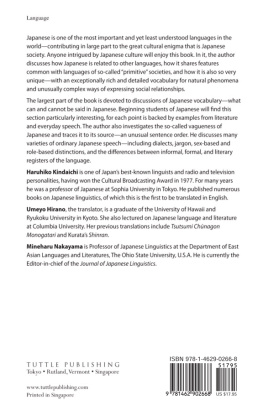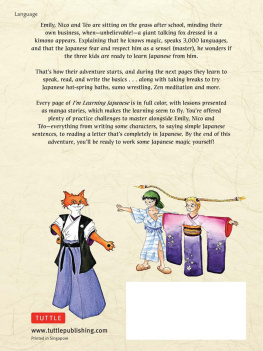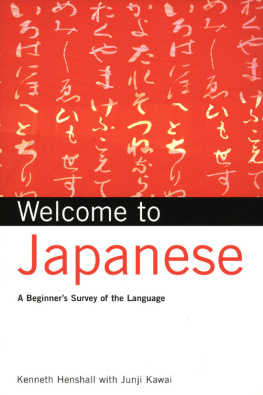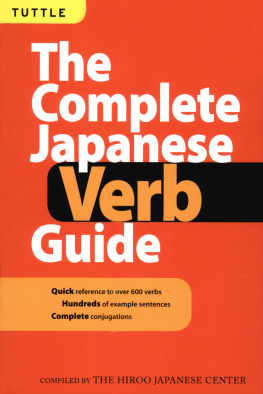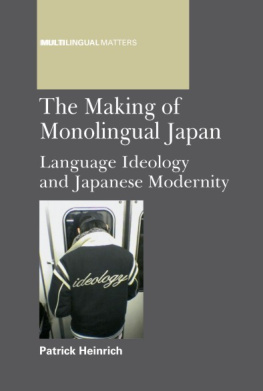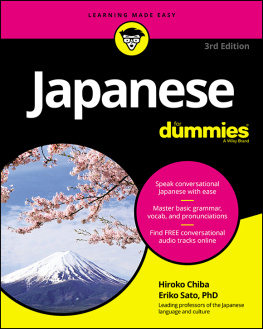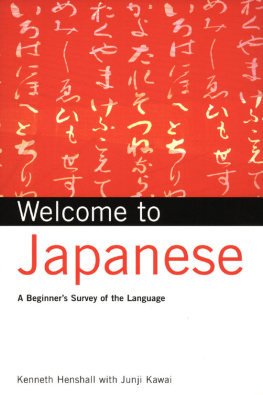the JAPANESE
LANGUAGE
the JAPANESE
LANGUAGE
by Haruhiko Kindaichi

Translated and Annotated by
Umeyo Hirano
With a new Foreword by
Mineharu Nakayama
T U T T L E P U B L I S H I N G
Tokyo Rutland,Vermont Singapore
Published by Tuttle Publishing, an imprint of Periplus Editions (HK) Ltd.
www.tuttlepublishing.com
Copyright in Japan 1978 by Charles E. Tuttle Company, Inc.
Copyright 2010 by Periplus Editions (HK) Ltd.
Originally published in Japan as Nippongo by Iwanami Shoten, Tokyo (1957).
All rights reserved. No part of this publication may be reproduced or utilized in any form or by any means, electronic or mechanical, including photocopying, recording, or by any information storage and retrieval system, without prior written permission from the publisher.
Library of Congress Control Number: 2010927332
ISBN 978-1-4629-0266-8
Distributed by
North America, Latin America & Europe
Tuttle Publishing
364 Innovation Drive
North Clarendon, VT 05759-9436 U.S.A.
Tel: 1 (802) 773-8930
Fax: 1 (802) 773-6993
info@tuttlepublishing.com
www.tuttlepublishing.com
Japan
Tuttle Publishing
Yaekari Building, 3rd Floor
5-4-12 Osaki
Shinagawa-ku
Tokyo 141 0032
Tel: (81) 3 5437-0171
Fax: (81) 3 5437-0755
tuttle-sales@gol.com
Asia Pacific
Berkeley Books Pte. Ltd.
61 Tai Seng Avenue #02-12
Singapore 534167
Tel: (65) 6280-1330
Fax: (65) 6280-6290
inquiries@periplus.com.sg
www.periplus.com
First bilingual edition
14 13 12 11 10 10 9 8 7 6 5 4 3 2 1
Printed in Singapore
TUTTLE PUBLISHING is a registered trademark of Tuttle Publishing, a division of Periplus Editions (HK) Ltd.
Publishers Foreword
No one would believe it now, but sixty years ago, the Japanese language was living on borrowed time. In the agonizing national reappraisal that followed defeat in World War II, even the most hallowed national institutions were subjected to keen scrutiny. The language itself was no exception.
Some peopleand not just the Americansblamed the war itself on the formality and complexity of the national idiom. At one time, the occupying authorities seriously considered replacing Japanese with English as the sole offcial language. And a renowned literary figure of the prewar period proposed the adoption of French.
It was in 1956, barely four years after the end of the occupation, that Haruhiko Kindaichi wrote his classic defense of the national language under the title of Nippongo. Rejecting the arguments of those who had predicted linguistic decline or degeneration, he pointed instead to the languages sturdy powers of assimilation. Far from collapsing under a tide of foreign words, Japanese was becoming bolder and more innovative.
Kindaichi was determined to explore all facets of his forbidding subject. To do so, he drew not only on the resources of the literature but also on Japans numberless dialects and professional jargons, about which he is the acknowledged expert. No one can emerge from this book without a feeling for the richness and complexity of the language spoken today throughout the world by over 130 million Japanese in all fields of human endeavor.
Foreword to the New Edition
Nippongo (The Japanese Language) was originally published in 1957 in Japan, and translated into English and published in 1978. I read this accessible and very insightful book for the first time while I was in college in Japan. It was before I became familiar with linguistic theories in the U.S. Now I am fortunate to be given an opportunity to read it again and discuss how pertinent to current linguistic theories Kindaichis original insights are.
First, I would like to remind readers to read the authors preface and the translators notes so that his essays can be placed into the context and time period of when this book was originally written. Being mindful of the historical context will allow his remarks to be interpreted appropriately.
PART I: The Position of Japanese presents Kindaichis view towards the Japanese language. He first discusses the origin of the language. As Shibatanis (1990) textbook title, The Languages of Japan, suggests, there is more than one language in Japan. They are Ainu and Japanese, which are considered unrelated whereas Ryukyuan is considered a dialect of Japanese. Generally speaking, Japanese is regarded as related to Korean, but Kindaichi thinks that supporting evidence for this view is insuffcient. Recently, Vovin (2009) also challenged this general view and argued against the idea that Japanese and Korean share the same ancestry. Unger (2009), on the other hand, supports the common origin hypothesis of the languages. Given new linguistic, methodological, and archeological developments, this again became a hot topic of debate.
PART II: Aspects of Speech refers to pragmatic and socio-linguistic aspects of the language. Speech styles commonly discussed in relation to politeness and gender issues deal with empowerment, but commonly accepted speech styles change over time as the society changes. Certain forms are registered as part of grammar. For instance, an appropriate honorific verbal form appears when the subject referent is exalted. This subject-verb agreement can be considered similar to morpho-syntactic subject-verb agreement seen in many languages including English. Osterhout and Inoue (2007), however, found in their study about the brains electrical activity (Event Related Potentials) that the brain activity for the subject-verb agreement in honorification (i.e., the appropriate use of honorific form) is not the same as that observed with the English subject-verb agreement. Furthermore, this brain activity on agreement was only seen among those who often used the honorific language. As we know, it takes time for Japanese speakers to acquire the honorific language. This is because of its situational complexity. Therefore, it was not strange for the study to find honorification grammaticalized among only those who were familiar with this type of language. Given the diversity of dialects and their media exposure today, speech styles have changed and so have peoples feeling toward them. In particular, mens and womens languages are moving toward more neutral styles, and given societal needs, more politically correct expressions are expected to increase in the near future, though not to the extent of those found in American English. Historical difference in speech style can be seen in this section.
PART III: Pronunciation offers segmental and suprasegmental analyses of the language. For instance, it discusses the difference between seion and dakuon, which is not necessarily the same as the difference between voiceless and voiced consonants. It refers to Norinagas finding that voiced consonants and the /r/ series do not appear at the beginning of a word in ancient Japanese. This reminds me of the fact that /r/ resists palatalization in Japanese mimetics (Tsujimura 2007). These may be related and may suggest the underlying restriction of /r/ in Japanese. Kindaichi also discusses the bimoraic rhythm of the language and the pitch characteristic of the word initial mora. The latter is well-known as Haraguchis (1977) Initial Lowering Rule in the Tokyo dialect. He also mentions that low pitch indicates word/phrase break, which relates to the down step prosodic characteristic. As can be seen, these segmental and prosodic characteristics Kindaichi discusses have been studied in more depth in recent years, and Optimality theoretic applications may be found from his insightful discussions as well.
Next page
